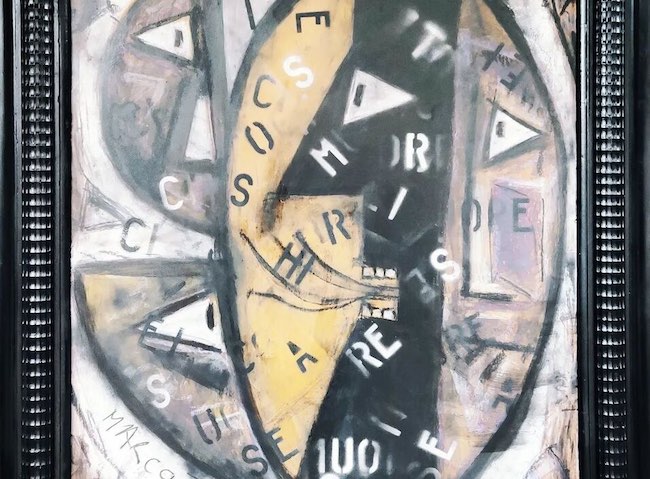Il percorso di osservazione e di approfondimento sulla realtà contemporanea conduce gli artisti a sviluppare, a elaborare un individuale linguaggio espressivo che deve necessariamente conformarsi non solo alla propria ispirazione creativa ma anche alla propria inclinazione naturale, quella attraverso la quale comprendono di essere maggiormente in grado di svelare, e interpretare, tutto ciò che appartiene alle pieghe della vita attuale. In alcuni casi più ermetici, in altri di più facile comprensione, e in alcuni stimolanti un’analisi sottile dall’immagine che ne fuoriesce, i linguaggi artistici costituiscono il mezzo di conoscenza e di manifestazione del pensiero, della filosofia e del desiderio di comprensione dell’oggettività di ciascun creativo. Il protagonista di oggi sceglie uno stile inconsueto eppure fortemente coinvolgente, in cui mescola caratteristiche di movimenti del passato riattualizzandoli e contaminandoli con atmosfere che prendono spunto dalla musica legata alle ideologie sociali della seconda metà del Novecento.
Intorno ai primi decenni del Ventesimo secolo cominciarono a delinearsi alcune correnti artistiche che non si limitavano a rompere gli schemi delle tradizioni pittoriche accademiche bensì si imposero di sperimentare e immettere all’interno delle opere d’arte elementi materici attraverso i quali introdurre nell’esperienza creativa, e successivamente visiva, anche la terza dimensione, la concretezza necessaria, proprio in quel periodo a cavallo tra le guerre mondiali, per uscire in qualche modo dalle brutture e dalle devastazioni a cui si era assistito. Precursore di tutti i movimenti materici che si susseguirono più tardi fu il Dadaismo, un gruppo i cui esponenti erano impegnati a creare un’anti-arte, un distacco dall’estetica, dal significato e dal tradizionalismo, a volte offensiva e irriverente, sui principi della quale fu possibile trasformare in arte ogni cosa; la Fontana di Marcel Duchamp fu emblema dello stile dadaista. L’introduzione di oggetti di uso comune nella composizione di un’opera fu poi reinterpretata e ampliata dall’Arte Informale che, nella sua accezione materica, ebbe in Antoni Tàpies e Alberto Burri la massima espressione di uno stile destinato a lasciare una profonda traccia; poco dopo infatti l’Arte Povera, di cui Jannis Kounellis fu grande interprete, diede un nuovo vigore alle linee guida informali incrementando l’utilizzo di materiali che divenivano sculture, installazioni od opere d’arte di grande intensità in cui l’equilibrio estetico era ormai assente e dove il significato era ermetico, doveva essere esplorato e meditato a fondo. Parallelamente in Francia sorse un altra corrente artistica, sollecitata e promossa da Jean Dubuffet, che era manifestazione spontanea e impulsiva di tutte quelle sensazioni latenti nelle interiorità delle persone ricoverate presso gli ospedali psichiatrici, ma che presto si ampliò divenendo un vero e proprio movimento in cui l’estetica era completamente esclusa poiché ciò che contava era esprimere le sensazioni più nascoste, le paure, le ansie, le angosce, una sorta di rivistazione delle inquietudini surrealiste ma con la spontaneità espressiva che non richiedeva particolari abilità tecniche. L’Art Brut, questo il nome del movimento, in qualche modo può essere collegata a tutto quel mondo giovanile delle grandi metropoli della seconda metà del Novecento che avevano ereditato le atmosfere scure dei Punk, in cui la rinuncia all’estetica e all’equilibrio erano funzionali alla ribellione alla società dell’epoca, riadattandole però e ammorbidendole con una maggiore moderazione, un sentimentalismo marcato oppure con la fascinazione nei confronti della tecnologia futuristica, prendendo in questo caso la denominazione di Cyberpunk.
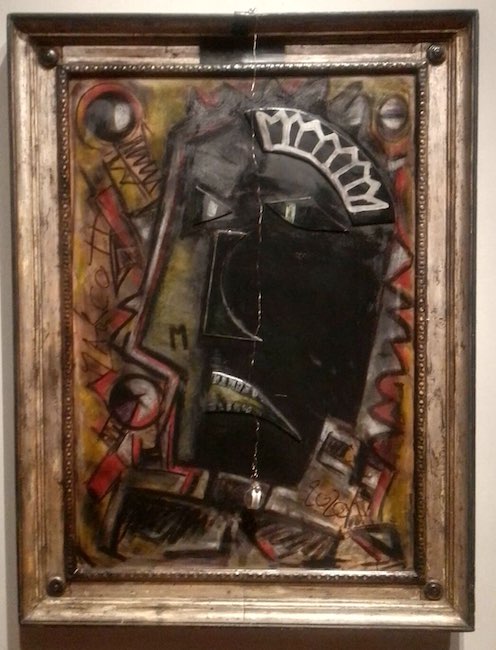
L’artista mantovano Giuseppe Marcotti raccoglie le esperienze artistiche di tutti questi movimenti, le mescola e le fonde per dare vita a una cifra stilistica assolutamente singolare e inusuale attraverso la quale non solo sperimenta i materiali ricomponendoli e assemblandoli per creare futuristiche sculture che riconducono l’immaginario comune alle atmosfere cinematografiche di Ritorno al futuro, ma si sofferma sull’oscurità delle ombre per interpretare il sentire dell’uomo moderno, quel suo essere a volte inconsapevolmente intrappolato all’interno di una serie di schemi e di convenzioni dalle quali non riesce più a uscire, vivendo tutta la sua esistenza convinto di esserne protagonista assoluto ignorando di essere invece solo parte di un semplice ingranaggio.
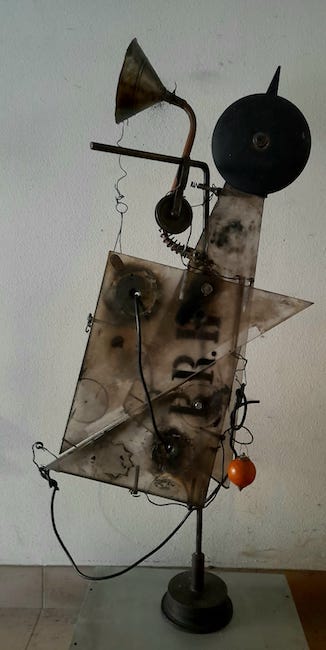
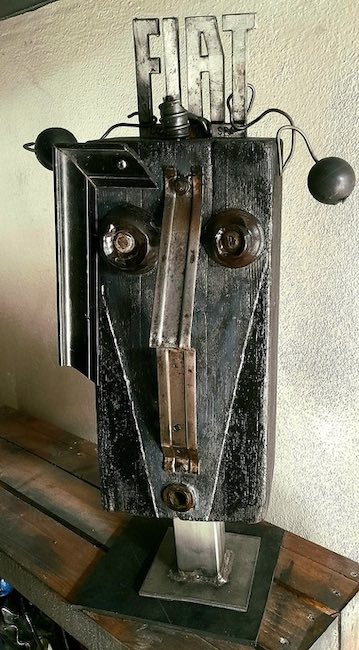
Nelle sue sculture assembla materiali per generare di fatto rappresentazioni fantastiche di volti o personaggi che hanno vagamente sembianze umane ma che in realtà sono costituiti da pezzi metallici, frammenti di plastica, legno, campanelli, sfere, fili di ferro, quasi Giuseppe Marcotti volesse enfatizzare la spersonalizzazione a cui la società ha abituato l’individuo, come se la sua umanità fosse messa in secondo piano rispetto al progresso o a un brand in cui riconoscersi; l’installazione-scultura Testa con logo, in cui uno dei simboli dell’industria automotiva italiana, la Fiat, è posta sopra il capo del personaggio, è esattamente la rappresentazione di un concetto, quello di identificazione e di omologazione, che laddove in principio fosse nato come simbolo di identità nazionale oggi invece si è trasformato in nostalgico e decadente ricordo di uno dei patrimoni in cui le persone non si identificano più a causa della globalizzazione.
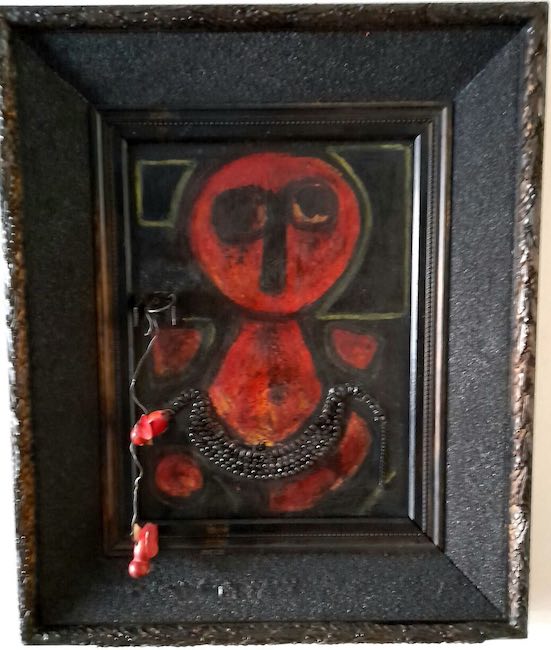
L’aspetto stilizzato del volto appare pertanto perplesso, quasi disorientato, incapace di staccarsi dal passato perché impossibilitato a trovare nuovi riferimenti nel presente. Nelle opere pittoriche invece, Giuseppe Marcotti mostra il suo lato più graffiante, quello in cui dall’oscurità dell’incoscienza lascia emergere dei barlumi di verità, considerazioni personali che però inducono l’osservatore alla riflessione; in questo tipo di opere lo stile diventa una mescolanza tra Arte Povera, perché l’apporto materico diviene fondamentale per mettere in evidenza il concetto e anche perché i materiali utilizzati sono di uso comune, fili di ferro, inserti di alluminio, collane, campane, omini di plastica, e vanno a completare la struttura costruita con l’apporto pittorico ampliandone e completandone il senso.
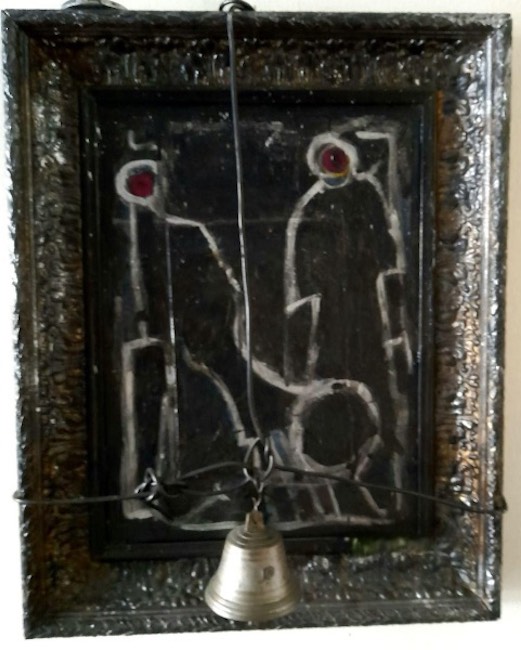
In Figure con campana la struttura compositiva si ispira agli omini stilizzati della Street Art e alla medesima immediatezza espressiva della Brut Art; ciò che colpisce di quest’opera è la marcata componente di ombra, ed è qui che le ambientazioni di Marcotti appaiono avvolte di atmosfere gotiche enfatizzate anche dalla cornice, che da un lato sembra essere dominante e simbolica del buio delle coscienze che contraddistingue l’essere umano contemporaneo, ma dall’altro il profilo bianco infonde speranza all’osservatore, come se un barlume di luce fosse solo nascosto sotto la cenere e pronto a fuoriuscire se correttamente sollecitato. Ecco così spiegata la funzione della campana, esterna alla parte pittorica, posta al centro e agganciata alla cornice, tracciante il confine di una sorta di gabbia, certo, ma pronta a suonare per risvegliare quelle coscienze addormentate. L’analisi della società contemporanea compiuta da Giuseppe Marcotti è sottile, quasi impercettibile perché celata dentro le sue figure antropomorfiche stilizzate e in alcuni casi primitive, eppure soffermandosi su di esse il senso comunicativo, l’arguta estrinsecazione del suo pensiero su ciò che ruota intorno all’essere umano e che costituisce l’esistenza moderna, arriva in modo chiaro e diretto.
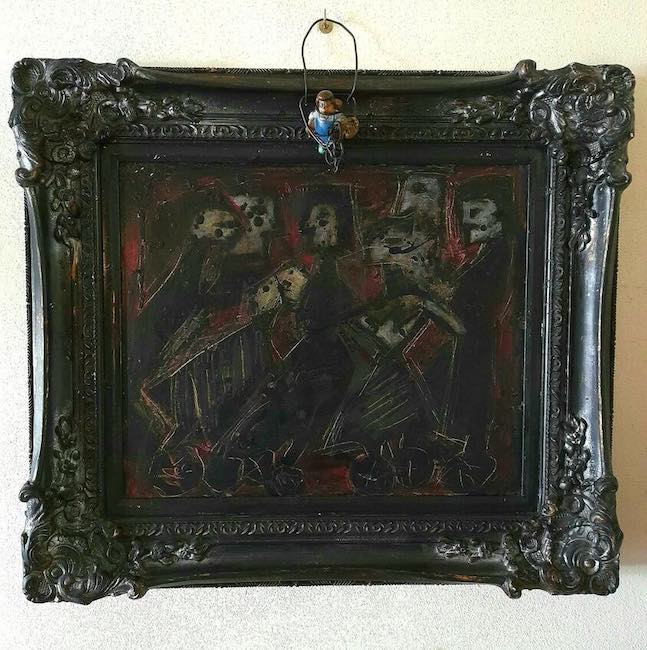
In Figure su ruote si manifesta ancora più chiaramente la tendenza attuale a giudicare chiunque mostri il coraggio di agire fuori dagli schemi, in maniera diversa da quella attesa o da quella messa in atto dalla maggior parte degli altri; i due personaggi sulle ruote infatti sono osservati con diffidenza, con distacco e probabilmente disapprovazione da parte degli altri in secondo piano, perché incapaci di comprendere la forza di non conformarsi a ciò che sembra essere giusto per la maggior parte. In alto la figura del piccolo pupazzo di plastica incatenato e con un cappio di metallo al collo appare come un’esplicazione del concetto, come volesse enfatizzare quelle catene mentali dentro le quali l’uomo tende a chiudersi e a limitare le possibilità di autonomia che per natura possiede; pertanto la persona fuori dagli schemi viene lasciata in disparte poiché pericolosa per quella rassicurante sonnolenza che sembra essere l’atteggiamento mentale più comune. L’artista compie così un’arguta osservazione della contemporaneità che traduce nei suoi lavori con uno stile immediato nella struttura visiva ma che richiede uno sforzo di approfondimento per la decifrazione del messaggio in esso contenuto.
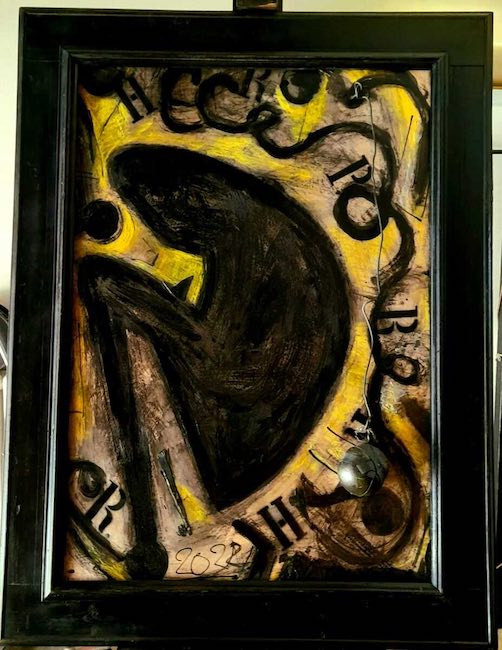
Giuseppe Marcotti ha al suo attivo mostre personali in Italia, partecipa a mostre collettive e fiere di settore sul terriorio nazionale e all’estero – Art Monaco ed Exposition d’Art Contemporain au Carrousel du Louvre – e una sua opera fa parte della collezione del Museo Ca’ la Ghironda di Bologna.
GIUSEPPE MARCOTTI-CONTATTI
Email: gianmarcomarcotti@gmail.com
Facebook: https://www.facebook.com/marcotti.giuseppe
Instagram: https://www.instagram.com/marcottigiuseppe/
The Gothic atmospheres by Giuseppe Marcotti, between Cyberpunk sculptures and paintings where Arte Povera merges with Brut Art
The path of observation and investigation into contemporary reality leads artists to develop, to elaborate an individual expressive language that must necessarily conform not only to their own creative inspiration but also to their natural inclination, the one through which they realize they are best able to unveil, and interpret, everything that belongs to the folds of current life. In some cases more hermetic, in others easier to understand, and in some stimulating a subtle analysis from the image that emerges, artistic languages constitute the means of knowledge and manifestation of the thought, philosophy and desire to understand the objectivity of each creative. Today’s protagonist chooses an unusual yet highly involving style, in which he mixes characteristics of movements from the past, bringing them up to date and contaminating them with atmospheres inspired by the music linked to the social ideologies of the second half of the 20th century.
Around the first decades of the 20th century, began to emerge a number of artistic currents that did not merely break the mould of academic pictorial traditions, but set out to experiment with and inject material elements into works of art, through which they could introduce the third dimension into the creative, and subsequently visual, experience, the concreteness that was needed, precisely at that period between the world wars, to somehow escape from the ugliness and devastation that had been witnessed. The forerunner of all later material movements was Dadaism, a group whose exponents were committed to creating an anti-art, a detachment from aesthetics, meaning and traditionalism, at times offensive and irreverent, on the principles of which it was possible to transform everything into art; Marcel Duchamp‘s Fountain was emblematic of the Dadaist style. The introduction of everyday objects into the composition of an artwork was later reinterpreted and expanded by Informal Art, which, in its material sense, had in Antoni Tàpies and Alberto Burri the highest expression of a style destined to leave a deep mark; shortly afterwards, Arte Povera, of which Jannis Kounellis was a great interpreter, gave new vigour to the informal guidelines by increasing the use of materials that became sculptures, installations or works of art of great intensity in which aesthetic balance was absent and where meaning was hermetic, had to be explored and pondered in depth. At the same time, in France arose another artistic current, stimulated and promoted by Jean Dubuffet, which was a spontaneous and impulsive manifestation of all those feelings latent in the inner selves of people in psychiatric hospitals, but which soon expanded to become a real movement in which aesthetics were completely excluded as what counted was expressing the most hidden feelings, fears, anguishes, a sort of reinterpretation of the surrealist anxieties but with the expressive spontaneity that did not require any particular technical skills. Art Brut, this is the name of the movement, can in some way be linked to the youthful world of the great metropolises of the second half of the 20th century that had inherited the dark atmospheres of Punk, in which the renunciation of aesthetics and balance were functional to the rebellion against the society of the time, adapting them, however, and softening them with greater moderation, marked sentimentalism or with a fascination with futuristic technology, in this case taking on the name Cyberpunk. Mantuan artist Giuseppe Marcotti gathers the artistic experiences of all these movements, mixes them and blends them to give life to an absolutely singular and unusual stylistic style through which he not only experiments with materials, recomposing and assembling them to create futuristic sculptures that bring the common imagination back to the cinematic atmospheres of Back to the Future, but also dwells on the darkness of shadows to interpret the feeling of modern man, his being at times unconsciously trapped within a series of schemes and conventions from which he can no longer escape, living his entire existence convinced that he is the absolute protagonist, unaware that he is instead only part of a simple cog. In his sculptures, he assembles materials to generate de facto fantastic representations of faces or characters that vaguely resemble human beings but are actually made of metal pieces, fragments of plastic, wood, bells, spheres, iron wires, almost as if Giuseppe Marcotti wanted to emphasise the depersonalisation to which society has accustomed the individual, as if his humanity were put in second place to progress or a brand in which he could recognise himself; the sculpture-installation Head with Logo, in which one of the symbols of the Italian automotive industry, Fiat, is placed above the head of the character, is exactly the representation of a concept, that of identification and homologation, which, where in the beginning it was born as a symbol of national identity, today has instead turned into a nostalgic and decadent reminder of one of the heritages with which people no longer identify due to globalisation. The stylised face therefore appears perplexed, almost disoriented, unable to detach itself from the past because it is unable to find new references in the present. In the pictorial works, on the other hand, Giuseppe Marcotti shows his more biting side, the one in which from the darkness of unconsciousness he allows glimmers of truth to emerge, personal considerations that induce the observer to reflect; in this type of artwork, the style becomes a mixture of Arte Povera, because the material contribution becomes fundamental in highlighting the concept, and also because the materials used are commonplace, iron wires, aluminium inserts, necklaces, bells, plastic little men, and they complete the structure built with the pictorial contribution, amplifying and completing its meaning.
In Figures with a Bell, the compositional structure is inspired by the stylised little men of Street Art and the same expressive immediacy as in Brut Art; what is striking about this work is the marked component of shadow, and it is here that Marcotti‘s settings appear enveloped in Gothic atmospheres also emphasised by the frame, which on the one hand seems to be dominant and symbolic of the darkness of conscience which characterises the contemporary human being, but on the other hand the white outline instils hope in the observer, as if a glimmer of light were only hidden under the ashes and ready to emerge if correctly stimulated. This explains the function of the bell, external to the pictorial part, placed in the centre and attached to the frame, marking the boundary of a sort of cage, certainly, but ready to ring to awaken those sleeping consciences. Giuseppe Marcotti‘s analysis of contemporary society is subtle, almost imperceptible because it is concealed within his stylised and in some cases primitive anthropomorphic figures, yet by dwelling on them, the communicative sense, the witty extrusion of his thought on what revolves around the human being and what constitutes modern existence, comes through clear and direct way. In Figures on Wheels, the current tendency to judge anyone who shows the courage to act outside the box, in a way that is different from what is expected or implemented by most others, is even more clearly manifested; the two characters on wheels are in fact observed with distrust, with detachment and probably disapproval by others in the background, because they are incapable of understanding the strength of not conforming to what seems to be right for most. Above, the figure of the small plastic puppet chained and with a metal noose around its neck appears as an explication of the concept, as if to emphasise those mental chains within which man tends to close himself up and limit the possibilities of autonomy that he possesses by nature; therefore the person outside the box is left aside because he is dangerous for that reassuring sleepiness that seems to be the most common mental attitude. The artist therefore makes a witty observation of contemporaneity that he translates into his artworks with a style that is immediate in its visual structure but requires an in-depth effort to decipher the message it contains. Giuseppe Marcotti has solo exhibitions in Italy, participates in group exhibitions and trade fairs in Italy and abroad – Art Monaco and Exposition d’Art Contemporain au Carrousel du Louvre – and one of his artworks is part of the collection of the Ca’ la Ghironda Museum in Bologna.


